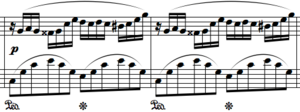Fantaisie-Impromptu facts for kids
The Fantaisie-Impromptu is a very famous piano song written by Frédéric Chopin. He wrote it in 1834. It's one of his most popular pieces, even though Chopin didn't want it published. His friend Julian Fontana shared it with the world after Chopin passed away.
How the Music is Built
This piece has a special structure called A B A Coda form. Think of it like a musical sandwich!
- The 'A' section is the main part, played at the beginning.
- The 'B' section is a different, often calmer, middle part.
- Then, the 'A' section comes back again.
- The 'Coda' is a short ending part that finishes the song.
Some parts of this piece might remind you of Ludwig van Beethoven's famous "Moonlight" Sonata.
Changes in Speed and Mood
The speed and mood of the music change throughout the Fantaisie-Impromptu.
- It starts with a fast and excited speed called allegro agitato. This means "fast and agitated."
- After the first 'A' section, it slows down a lot for a couple of measures to largo, which means "very slow."
- The 'B' section is played at a medium speed called moderato cantabile. This means "moderately, in a singing style." It's often very beautiful and calm.
- Finally, after the 'B' section, the music becomes very fast again, called presto. This means "very fast."
The piece ends with a special kind of chord called a C-sharp major rolled chord.
Images for kids
-
Cadenza (measure 188), Beethoven's Piano Sonata No. 14, third movement
See also
 In Spanish: Fantaisie-Impromptu para niños
In Spanish: Fantaisie-Impromptu para niños

All content from Kiddle encyclopedia articles (including the article images and facts) can be freely used under Attribution-ShareAlike license, unless stated otherwise. Cite this article:
Fantaisie-Impromptu Facts for Kids. Kiddle Encyclopedia.

